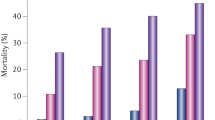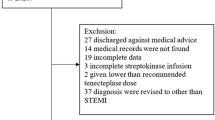Abstract
We report the management of the 831 patients from 18 hospitals which constituted the Irish component of the 17,183 subjects enrolled in the ISIS-2 trial which studied the effects of streptokinase infusion and aspirin therapy given to patients presenting within 24 hours of the onset of suspected acute myocardial infarction.
34% of Irish patients (IP) presented for treatment within 4 hours of the development of symptoms. This compared to 44% of the overall group (OG) (p<0.001). This represented the lowest percentage of patients presenting within 4 hours in any of the participating countries. The mean delay time from onset of symptoms was 7.9 hours in IP compared to 6.9 in OG (p<0.001). The mean delay time in Ireland was longer than the mean delay time in any of the participating countries. The mean age and systolic blood pressure at presentation was similar in both groups.
It was planned to treat 12% IP with aspirin compared to 10% OG (p-NS), and 71% IP with subcutaneous heparin compared with 47 % OG (p<0.001). Intravenous heparin was planned treatment in 20% IP and 24% OG (p<0.01). Planned oral anticoagulant therapy was similar in both groups (p-NS). Planned use of intravenous betablockers occurred in only 2% IP and 6% OG (p<0.001).
9% IP and 22% OG received steroids before streptokinase infusion (p<0.001). 65% IP and 47% OG received subcutaneous heparin (p<0.001). The use of intravenous heparin and oral anticoagulants was similar in IP and OG (p-NS). Only 1% IP received intravenous betablocker therapy versus 5% OG (p<0.001).
6% IP and 11% OG were discharged on oral anticoagulants (p<0.001). There was similar use of nontrial aspirin in both groups (p-NS). 16 % IP were discharged on betablocker therapy compared to 32% OG (p<0.001).
In conclusion IP were similar to OG in baseline characteristics. IP presented later for therapy, received more subcutaneous heparin, and less intravenous steroids before streptokinase infusion. Less IP received oral betablockade on discharge.
Similar content being viewed by others
References
ISIS-2 (Second International Study of Infarct Survival) Collaborative Group: Randomised trial of intravenous streptokinase, oral aspirin, both or neither among 17, 187 cases of suspected acute myocardial infarction. Lancet 1988: 2, 349–360.
Yusuf, S., Peto, R., Lewis, J., Collins, R., Sleight, P. Beta-blockade during and after myocardial infarction. An overview of the randomised trials. Prog. Cardiovasc. Dis. 1985: 17, 335–371.
ISIS-1 (First International Study of Infarct Survival) Collaborative Group: Randomised trial of intravenous atenolol among (16,027) cases of suspected acute myocardial infarction: ISIS-1. Lancet 1986: 2, 57–65.
The Norwegian Multicenter Study Group. Timolol induced reduction in mortality and reinfarction in patients surviving acute myocardial infarction. N. Eng. J. Med. 1981: 304, 801–7.
Beta-blocker Heart Attack Trial Research Group. A randomised trial of propranolol in patients with acute myocardial infarction. JAMA 1982: 247, 1707–14.
Bater, N. S., Julian, D. G., Lewis, J. A., Rose, G. B blockers after myocardial infarction: have trials changed practice? Br. Med. J. 1984: 289, 1431–2.
Mitchell, J. R. A. Anticoagulants in coronary heart disease: Retrospect and prospect. Lancet 1981: 1, 257–262.
Gallus, A. S., Hirsh, J., Tuttle, R. J. et al. Small subcutaneous doses of subcutaneous heparin in the prevention of deep-vein thrombosis after myocardial infarction. N. Engl. J. Med. 1973: 288, 545.
Warlow, G., Beattie, A. G., Terry, G. et al. A double blind trial of subcutaneous heparin in the prevention of deep-vein thrombosis after myocardial infarction. Lancet 1973: 2, 934.
Emerson, P. A., Marks, P. Preventing thromboembolism after myocardial infarction: Effect of low-dose heparin or smoking. Br. Med. J. 1977: 1, 18.
MacMahon, B., Kelly, P., Brangan, P., Walsh, M. J. Report on the Dublin Cardiac Ambulance Service. Ir. Med. J. 1983: 76, 168–170
Author information
Authors and Affiliations
Consortia
Rights and permissions
About this article
Cite this article
MacGowan, G.A., O’Callaghan, D., Horgan, J.H. et al. Medical management of acute myocardial infarction in Ireland: Information from the second international study of infarct survival (ISIS - 2). I.J.M.S. 160, 347–349 (1991). https://doi.org/10.1007/BF02957892
Issue Date:
DOI: https://doi.org/10.1007/BF02957892




